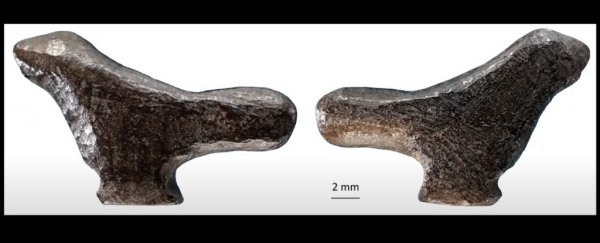A tiny carving of a bird, found in a discarded pile of soil, has now been declared the oldest work of art ever found in China. The figure is at least 13,000 years old, and hints at an original artistic tradition in the region.
Roughly 12 millimetres tall (half an inch), this dainty figurine pushes back the origins of animal sculptures in East Asia by more than 8,500 years: from the New Stone Age, when humans began to settle down and farm, to the Old Stone Age, when hunter-gatherers reigned.
"The Lingjing figurine is the only Palaeolithic three-dimensional object carved in burnt bone and representing a bird standing on a pedestal," an international team of researchers writes in a new study describing the find.
"It is also the only Palaeolithic carving for which, thanks to its exceptional state of preservation, the final stages of manufacture could be documented in detail."
Birds, and especially 'perching birds', are a common theme in ancient Chinese art from the Neolithic, or the New Stone Age, when early humans were gradually becoming more settled and had more time for leisure.
This new discovery, however, suggests carving was a creative pastime in this region long before that. Analysing the figurine and surrounding material at four different research institutions around the world - including China, France, Japan and the US - scientists now think it was made between 13,400 and 13,200 years ago, just a few hundred kilometres from where modern Beijing now sits.
The sophisticated sculpting process, still visible in the figurine today, implies a long-standing artistic tradition that extends well into the Palaeolithic, the authors argue, which extends all the way back to about 30,000 years before today.
Under ideal circumstances, proving such a tradition would require several examples of shared technical, thematic, and stylistic traits, but given how detailed this one single figurine is, the research team thinks there was probably a rich history of sculpting in this area.
In 2005, during the first excavations in Lingjing, researchers found a layer of soil that had been removed to dig a well in 1958. Luckily enough, the dirt had been heaped nearby, and sifting through pottery shards and burned animal remains, the team found this one little bird, perched on its platform, no longer than 20 millimetres.
The orientation of the figurine's bone structure suggests it was carved from a mammal's limb bone, and its colour gradient indicates some sort of controlled heating process to shape the bone and shrink it.
While the new figurine found in Lingjing lacks wings, the authors say its outline, featuring an oversized tail, head, throat, breast and belly - not to mention the clear marks found where the eyes and bill should have been - almost perfectly matches that of a bird.
In particular, they say, it looks like it belongs to the order Passeriformes, which encompasses half of all known bird species alive today.
"Our analysis reveals that the Lingjing artist has chosen the appropriate techniques and applied them skillfully to faithfully reproduce the distinct anatomical features of a passerine," the authors write.
"The style of this diminutive representation is original and remarkably different from all other known Palaeolithic avian figurines."
Today, we still don't know when humans first started making representational art. The first symbolic ornaments, pigments and engravings date back to at least 100,000 years ago, and while sculpture is thought to be one of the earliest art forms, we haven't found many examples to work with.
The oldest statues carved from mammoth ivory and depicting animals didn't show up in Europe until about 40,000 years ago, and few other carvings from the same time have been found elsewhere in the world.
In fact, the only other Palaeolithic bird carvings from Asia consist of pendants made of ivory and antler, representing flying waterfowls, and they were discovered in Siberia. The next oldest figurine in Chinese Neolithic art is a jade songbird from approximately 5,000 BCE.
Passeriformes are commonly known as 'perching' or 'landing' birds, and in the ancient past, this order was often featured in Chinese art. In the case of the Lingjing sculpture, the short legs that define these birds have been replaced with a rectangular pedestal, which is sometimes seen in art sculptures found further west.
"The figurine differs technologically and stylistically from other specimens found in Western Europe and Siberia, and it could be the missing link tracing the origin of Chinese statuary back to the Palaeolithic period," the authors argue.
More examples will be needed before we can say for sure whether this bird represents an entire ancient tradition of artistic sculpting in East Asia; given the circumstances of this lucky discovery, the odds of finding more might not be in our favour - but we'll keep hoping.
The study was published in PLOS One.
